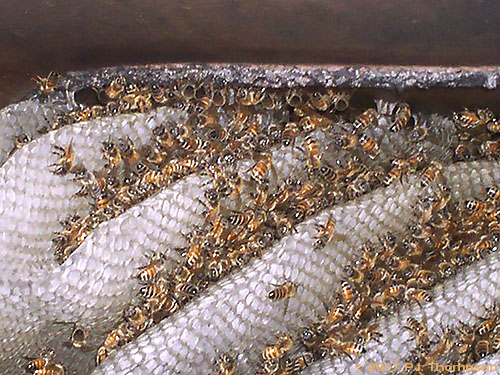
Honeybees seek out sheltered, darkened enclosures in which to establish their colonies.
Wild or “escaped” bee colonies nest in attics, between the wall studs of houses, garages or other buildings, within porch roofs or in similar areas.
Bees can get into your home through cracks in walls and house vents that have no screening — any bee-sized gap can be an entry point. Bees will also nest in tree hollows, under rocky shelters (such as cracks and overhangs), and dry caves. Beekeepers keep their colonies in boxes called hives.
When a bee colony becomes too large it divides by swarming. A honeybee swarm contains thousands of workers and their queen. A swarm of bees will cluster temporarily at one location while scout bees locate a new home. When a suitable location is found the swarm moves in as a group. A swarm of honeybees may last a few hours or days. Honeybees in a swarm are usually gentle because they have full honey stomachs, but it is never a good idea to disturb them.
Bees that swarm or nest in locations inconvenient to humans are considered pests. Whether in a swarm or a colony, bees nesting in houses or other structures are an unwelcome addition to a home owner’s property.
Swarms usually settle in trees and shrubs, and are seen in a large hanging cluster — see the swarms page for photos. If a swarm has found an entry into your home and has been there a short time, see the trap-outs page for information. If the colony has been established for a longer period, please see the cutouts page for information.

© 2017 Bee Removal Guys
Web design by P.J. Thompson
All artwork and photographs © 2017 P.J. Thompson




